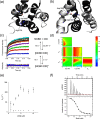Mapping the transition state for a binding reaction between ancient intrinsically disordered proteins
- PMID: 33454008
- PMCID: PMC7762952
- DOI: 10.1074/jbc.RA120.015645
Mapping the transition state for a binding reaction between ancient intrinsically disordered proteins
Abstract
Intrinsically disordered protein domains often have multiple binding partners. It is plausible that the strength of pairing with specific partners evolves from an initial low affinity to a higher affinity. However, little is known about the molecular changes in the binding mechanism that would facilitate such a transition. We previously showed that the interaction between two intrinsically disordered domains, NCBD and CID, likely emerged in an ancestral deuterostome organism as a low-affinity interaction that subsequently evolved into a higher-affinity interaction before the radiation of modern vertebrate groups. Here we map native contacts in the transition states of the low-affinity ancestral and high-affinity human NCBD/CID interactions. We show that the coupled binding and folding mechanism is overall similar but with a higher degree of native hydrophobic contact formation in the transition state of the ancestral complex and more heterogeneous transient interactions, including electrostatic pairings, and an increased disorder for the human complex. Adaptation to new binding partners may be facilitated by this ability to exploit multiple alternative transient interactions while retaining the overall binding and folding pathway.
Keywords: IDP; coupled binding and folding; intrinsically disordered proteins; phi value analysis; pre-steady-state kinetics; protein binding; protein complex; protein evolution; protein folding; transition state.
Copyright © 2020 © 2020 Karlsson et al. Published by Elsevier Inc. All rights reserved.
Conflict of interest statement
The authors declare that they have no conflicts of interest with the contents of this article
Figures





Similar articles
-
A structurally heterogeneous transition state underlies coupled binding and folding of disordered proteins.J Biol Chem. 2019 Jan 25;294(4):1230-1239. doi: 10.1074/jbc.RA118.005854. Epub 2018 Dec 4. J Biol Chem. 2019. PMID: 30514761 Free PMC article.
-
Structure and dynamics conspire in the evolution of affinity between intrinsically disordered proteins.Sci Adv. 2018 Oct 24;4(10):eaau4130. doi: 10.1126/sciadv.aau4130. eCollection 2018 Oct. Sci Adv. 2018. PMID: 30397651 Free PMC article.
-
A folded excited state of ligand-free nuclear coactivator binding domain (NCBD) underlies plasticity in ligand recognition.Biochemistry. 2013 Mar 12;52(10):1686-93. doi: 10.1021/bi4001062. Epub 2013 Mar 1. Biochemistry. 2013. PMID: 23373423
-
Insights into Coupled Folding and Binding Mechanisms from Kinetic Studies.J Biol Chem. 2016 Mar 25;291(13):6689-95. doi: 10.1074/jbc.R115.692715. Epub 2016 Feb 5. J Biol Chem. 2016. PMID: 26851275 Free PMC article. Review.
-
Role of Intrinsic Protein Disorder in the Function and Interactions of the Transcriptional Coactivators CREB-binding Protein (CBP) and p300.J Biol Chem. 2016 Mar 25;291(13):6714-22. doi: 10.1074/jbc.R115.692020. Epub 2016 Feb 5. J Biol Chem. 2016. PMID: 26851278 Free PMC article. Review.
Cited by
-
Molecular Details of a Coupled Binding and Folding Reaction between the Amyloid Precursor Protein and a Folded Domain.ACS Chem Biol. 2021 Jul 16;16(7):1191-1200. doi: 10.1021/acschembio.1c00176. Epub 2021 Jun 23. ACS Chem Biol. 2021. PMID: 34161732 Free PMC article.
-
Fuzziness and Frustration in the Energy Landscape of Protein Folding, Function, and Assembly.Acc Chem Res. 2021 Mar 2;54(5):1251-1259. doi: 10.1021/acs.accounts.0c00813. Epub 2021 Feb 8. Acc Chem Res. 2021. PMID: 33550810 Free PMC article. Review.
-
The dynamic properties of a nuclear coactivator binding domain are evolutionarily conserved.Commun Biol. 2022 Mar 30;5(1):286. doi: 10.1038/s42003-022-03217-y. Commun Biol. 2022. PMID: 35354917 Free PMC article.
-
Multivalent Interaction of Beta-Catenin With its Intrinsically Disordered Binding Partner Adenomatous Polyposis Coli.Front Mol Biosci. 2022 Jun 8;9:896493. doi: 10.3389/fmolb.2022.896493. eCollection 2022. Front Mol Biosci. 2022. PMID: 35755812 Free PMC article.
-
Evolutionary fine-tuning of residual helix structure in disordered proteins manifests in complex structure and lifetime.Commun Biol. 2023 Jan 18;6(1):63. doi: 10.1038/s42003-023-04445-6. Commun Biol. 2023. PMID: 36653471 Free PMC article.
References
Publication types
MeSH terms
Substances
LinkOut - more resources
Full Text Sources
Miscellaneous

